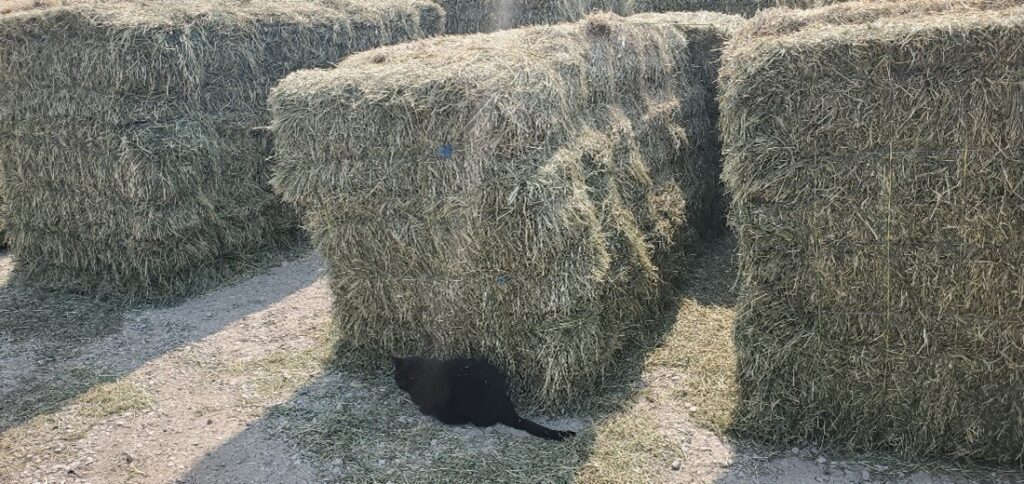Winter 2022/2023 Conditions
Fall 2022 was open and mostly dry. Growth on annual forages and regrowth on hay fields was faster than usual. Snow cover over the winter was less than normal, with frequent thaws and rain events. Ice sheeting was flagged as a potential problem in eastern Ontario. April had more precipitation than average across most of the province. Snow meltwater in many areas drained away rapidly this spring, leaving soil surface conditions drier than usual.
Hay and Haylage
Alfalfa overwintered well across the province, despite reduced snow cover. Some fields that were harvested in the fall did not overwinter as well.
May was very dry across the province. Corn and soybean planting finished early, and with another two weeks of hot, dry weather in the forecast, many farms put up an early first cut as dry hay. Although the crop felt and tested dry, the immature crop held onto stem moisture more than it would at the normal mid-June harvest timing. There was an increased risk of spontaneous combustion due to bales re-wetting from this retained moisture (Figure 1).

Figure 1. Bale bundles slump due to high stem moisture. Harvested May 2023.
Alfalfa weevil pressure was high in the southwest and control options were limited as a result of the Pest Management Regulatory Agency re-evaluation, that cancelled lambda-cyhalothrin products for all feed uses, effective April 29, 2023. This change affects available insecticide options to manage weevils. Regrowth in some fields struggled to get ahead of weevil pressure. Potato leafhopper arrival was later than usual, as summer thunderstorms did not begin until late June.
Northwestern Ontario continued to be dry for the remainder of the growing season. Heavy dew and frequent rainfall affected harvest timing and quality on second and third cut in much of the province.
Feed inventories tend to be above normal, but some of this is due to carry-over from last year. Yields for 2023 tended to be average or above average.
Pastures
Dry conditions followed by cool weather in the spring slowed pasture growth compared to normal. Above-average rainfall in July across much of the province helped maintain pasture production and reduced the summer slump.
Annual Forage Crops
Winter cereals overwintered well. Harvest began the third week of May in southwestern Ontario, and the following week in central and eastern Ontario. Winter triticale yields were reported as being good to above average while rye yields were variable. Quality tended to be good, since dry spring conditions enabled timely harvest.
Silage corn yields were excellent overall, although the dry matter content was more variable than in 2022. The 2023 Ontario Grain Corn Ear Mould and Deoxynivalenol (DON) Mycotoxin Survey found 77% of samples tested low (<2.00 parts per million (ppm)) for DON. This is fewer low-testing samples than the 10-year average of 88%, but better than recent higher-testing years of 2018 and 2016.
Bt-resistant corn rootworm is a serious pest of continuous corn and is a major threat to the silage corn supply across the province. Producers are encouraged to work with their agronomist and nutritionist to create a forage crop plan with a good crop rotation. Growers should also talk to their corn seed supplier about purchasing hybrids without below-ground protection for first- and second-year corn. More information on managing Bt-resistant corn rootworm can be found on FieldCropNews.com. Sorghum-sudangrass yields were good. An open fall allowed many producers to take a larger final cut than they may have had in recent years.
Agricorp
The Forage Rainfall plan offers coverage for established hay and pasture for insufficient rainfall and excessive rainfall. The forage growing season has been variable across the province. Wet weather conditions at harvest in some areas of the province resulted in crop damage and difficulty in getting forage cut and baled.
Claim payments for the excess rainfall option were paid across the province to producers in August for a total of $1.2 million, which is less than the 5-year average of $2.7 million. The insufficient rainfall option claims were paid in September for a total of $2.3 million, which is in line with 2022 insufficient rainfall payments. The highest payout years to date was 2021 ($11 million), followed by 2020 ($8 million) and 2016 ($7.5 million). There were 293,000 acres insured under the standard and premium options of the New Forage Seeding production insurance program in 2023. Total claims paid were $1.627 million.
Upcoming Events
December 5-7: Forage Focus. Free webinars, noon Eastern/11 am Central. For program and to register visit https://onforagenetwork.ca/ontario-forage-council/forage-focus/
March 5-7: Profitable Pastures. Free webinars, 8 pm Eastern/7 pm Central. Details will be made available at https://onforagenetwork.ca/ontario-forage-council/profitable-pastures/